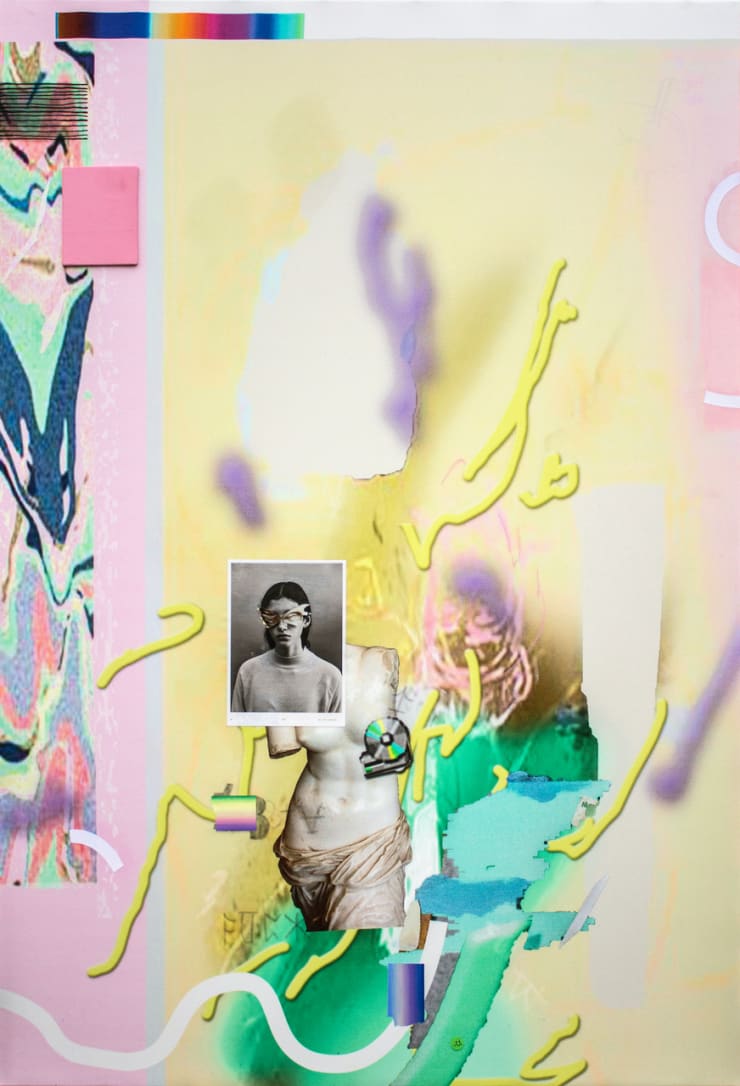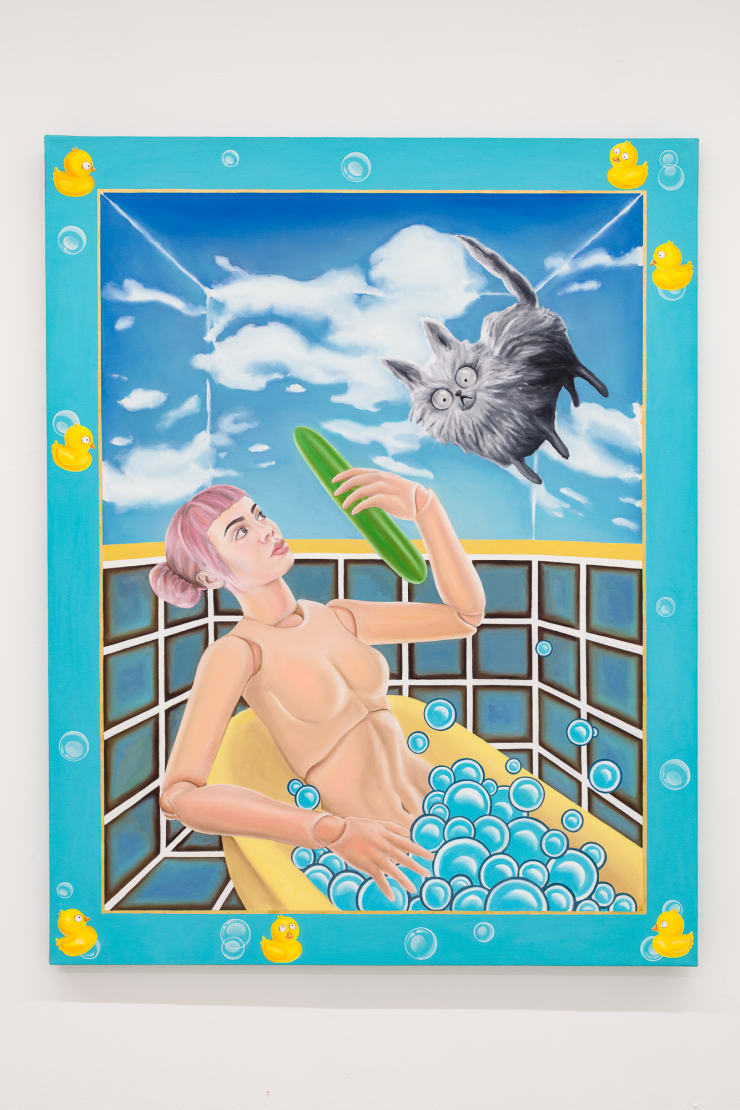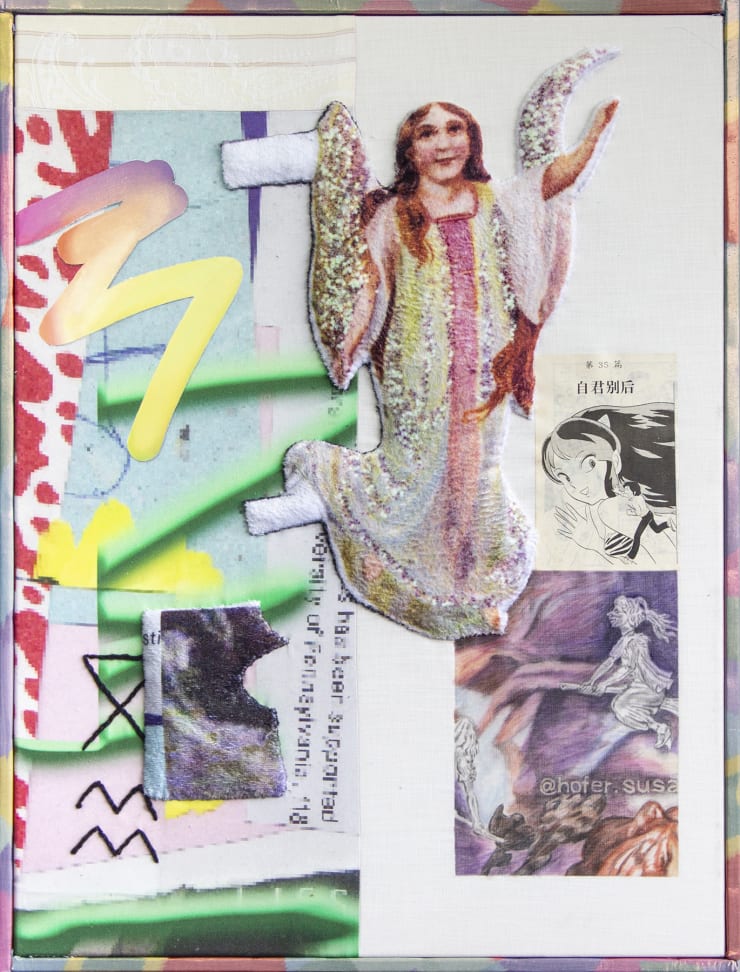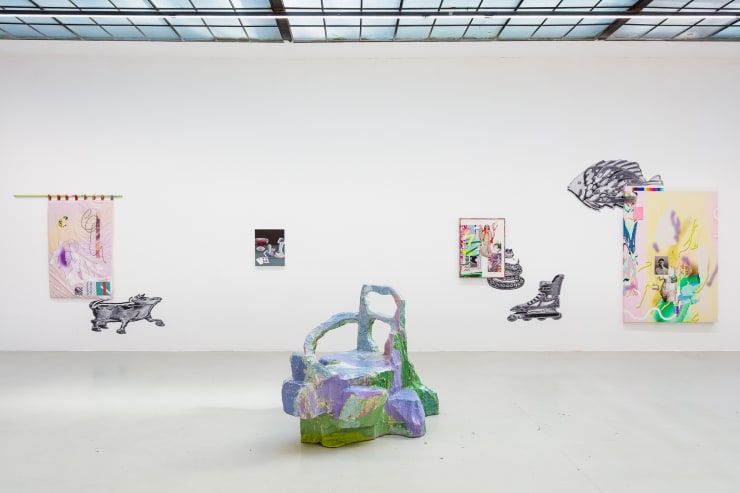Rhizome I Images of thought
Opening: Thursday, 5 March 6.00pm
Tali Lennox | Nana Mandl | Jillian Mayer | Siggi Sekira | Katerina Zbortkova
In her colourful collages, pictures, prints, and sculptures, Nana Mandl (*1991 Graz, AT) develops possible visual transformations and translations of the challenges and the excessive demands of today's media. Her haptic collages combine elements of painting, embroidery and drawing with forms of the communicative and representative spheres of advertising, fashion and social media. Her multilayered works also reflect the globalized patchwork society in which we are living in today.
The artist Jillian Mayer (*1986 Miami, US) explores the impact of the digital world on our lives, our bodies, and our identities. Her so-called “slumpies" celebrate those invisible networks that are tightly intertwined through Instagram, Snapchat, Twitter, etc. and support the use of the telephone in a pleasant way. Mayer's videos such as “I Am Your Grandma" are autobiographical diary entries, which the artist records for her unborn grandchildren. The work questions notions of mortality, fame, and the universal impetus for creation and legacy. By placing the video into a public forum like Youtube, Mayer investigates phenomenologically why people ultimately share their personal feelings with anonymous strangers.
The sculptures by the artist Siggi Sekira (*1987 Odessa, UA) reinterpret Slavic mythology and investigate the coexistence of paganism and Christianity in rural, post- Soviet Ukraine. Pottery is exemplary of Ukrainian folk traditions and a form of cultural expression of the working class. With her sculptures, Sekira creates her own worlds alongside our present-day society and shows two works from the series „The Eve of Nymphs", which are based on the Slavic fertility ritual of Ivan Kupala.
Katerina Zbortkova’s (*1986 Tabor, CZE) series of paintings star Lil Miquela, a real life mannequin, sculpted by her Silicon Valley puppeteers. She lives in an unsettling fantasy world, engineered by Instagram algorithms and patriarchal beauty standards. In each of these exuberant canvasses Miquela is seen enacting various viral internet phenomena of the 21st century. Seemingly ephemeral online obsessions such as ‘what colour is the dress’ and ‘cats vs cucumbers’ are resurrected here in oil, from URL to IRL. To her fans Miquela is an inspiration. The sincerity of her online confessionals, and the energy of her perky pop music speak to a generation searching for a feeling.
The paintings of Tali Lennox (*1993 London, UK) are links and mediators between our real-life sphere and the spiritual one. Her impressive portraits draw parallels between German art of the 1920s and of the current 2020s. Lennox describes in particular the latter as a time of political and ecological decline, which captures the glittering escapism in a time of impending uncertainty. The people portrayed in Lennox's work are mostly strangers whom she meets on the streets of New York and then photographs in a staged fashion that matches their stories.
RHIZOME
Images of Thought
Tali Lennox | Nana Mandl | Jillian Mayer | Siggi Sekira | Katerina Zbortkova
Galerie Kandlhofer präsentiert die Multimedia-Ausstellung Rhizome - Images of Thought, mit Werken von fünf internationalen Künstlerinnen. Die Arbeiten von Tali Lennox (*1993 London, UK), Jillian Mayer (*1986 Miami, US), Nana Mandl (*1991 Graz, AT), Siggi Sekira (*1987 Odessa, UA) und Katerina Zbortkova (*1986 Tabor, CZ) stehen exemplarisch für eine Generation, die hochmoderne Praktiken, Interesse an Kollaboration und materielle Transformation zu Leitprinzipien gemacht hat. Rhizome zeigt neue Werke aus den Bereichen Malerei, Skulptur und Videoinstallation als Manifestationen künstlerischer Gedankenbilder.
Die Gruppenausstellung entwickelt eine Praxis der Realitätserweiterung, welche ein Nachdenken über die eigene Erfahrung und daraus resultierende Folgen bewirkt. Das Beobachten eines Ereignisses beeinflusst die Wirklichkeit und auch das Resultat. Dieses Phänomen trifft auf kleinsten Skalen, wo die Natur den Gesetzen der Quantenmechanik folgt, ebenso zu wie in der beobachtbaren Welt mit alltäglichen Situationen.
Die Skulpturen der Künstlerin Siggi Sekira (*1987 Odessa, UA) interpretieren die slawische Mythologie neu und untersuchen das Koexistieren von Heidentum und Christentum in der ländlichen, postsowjetischen Ukraine. Keramik ist beispielhaft für ukrainische Volkstraditionen und eine kulturelle Ausdrucksform der Arbeiterklasse. Mit ihren Skulpturen erschafft Sekira neben unserer heutigen Gesellschaft ihre eigenen Welten und zeigt zwei Arbeiten aus der Serie „The Eve of Nymphs“ die auf dem slawischen Fruchtbarkeitsritual Ivan Kupala basieren.
-
 Nana Mandldon't be so fucking nostalgic babe, 2016Mixed Media on Canvas190 x 130 cm
Nana Mandldon't be so fucking nostalgic babe, 2016Mixed Media on Canvas190 x 130 cm
74 3/4 x 51 1/8 in -
 Jillian MayerSlumpie 50 - The ResortFibreglas, polyurethane plastic, wood and acryl119 x 119 x 116 cm
Jillian MayerSlumpie 50 - The ResortFibreglas, polyurethane plastic, wood and acryl119 x 119 x 116 cm -
 Tali Lennox Curtain Call for Linda Leven, Room 629, 2020 Oil on canvas 76.2 x 101.6 cm 30 x 40 in
Tali Lennox Curtain Call for Linda Leven, Room 629, 2020 Oil on canvas 76.2 x 101.6 cm 30 x 40 in -
 Siggi SekiraNine Little Murmurs, 2019Glazed stoneware33 x 13 x 31 cm
Siggi SekiraNine Little Murmurs, 2019Glazed stoneware33 x 13 x 31 cm
13 x 5 1/8 x 12 1/4 in -
 Katerina ZbortkovaCats vs. Cucumbers, 2019Oil on canvas150.5 x 118 cm
Katerina ZbortkovaCats vs. Cucumbers, 2019Oil on canvas150.5 x 118 cm
59 1/4 x 46 1/2 in -
 Tali LennoxClosing Hour, 2020Oil on canvas121.9 x 101.6 cm
Tali LennoxClosing Hour, 2020Oil on canvas121.9 x 101.6 cm
48 x 40 in -
 Tali LennoxBroken Ballerina, 2020Oil on canvas51 x 41 cm
Tali LennoxBroken Ballerina, 2020Oil on canvas51 x 41 cm
20 1/8 x 16 1/8 in -
 Siggi SekiraApril´s News, 2019Glazed stoneware44 x 21 x 10 cm
Siggi SekiraApril´s News, 2019Glazed stoneware44 x 21 x 10 cm
17 3/8 x 8 1/4 x 4 in -
 Jillian MayerI Am Your Grandma, 2011Video, 1 min 03 sec
Jillian MayerI Am Your Grandma, 2011Video, 1 min 03 sec -
 Jillian MayerMakeup Tutorial - How To Hide From Cameras, 2013Video, 3 min 37 sec
Jillian MayerMakeup Tutorial - How To Hide From Cameras, 2013Video, 3 min 37 sec -
 Katerina ZbortkovaSpoon Shower, 2019Oil on canvas150.5 x 118 cm
Katerina ZbortkovaSpoon Shower, 2019Oil on canvas150.5 x 118 cm
59 1/4 x 46 1/2 in -
 Nana Mandl7heaven, 2019foam material-collage27 x 22 x 6 cm
Nana Mandl7heaven, 2019foam material-collage27 x 22 x 6 cm
10 5/8 x 8 5/8 x 2 3/8 in -
 Nana Mandlmy very own muse I, 2019mixed media on glass80 x 50 cm
Nana Mandlmy very own muse I, 2019mixed media on glass80 x 50 cm
31 1/2 x 19 3/4 in -
 Nana Mandlmy very own muse II, 2019mixed media on glass80 x 50 cm
Nana Mandlmy very own muse II, 2019mixed media on glass80 x 50 cm
31 1/2 x 19 3/4 in -
 Nana Mandlmy very own muse III, 2019mixed media on glass80 x 50 cm
Nana Mandlmy very own muse III, 2019mixed media on glass80 x 50 cm
31 1/2 x 19 3/4 in -
 Nana Mandlwitchcraft-media, 2020mixed media on canvas63 x 83 cm
Nana Mandlwitchcraft-media, 2020mixed media on canvas63 x 83 cm
24 3/4 x 32 5/8 in -

Nana Mandl,
head and heartache,
2020
-

Nana Mandl,
the good and the bad,
2019
-

Katerina Zbortkova,
Prestigio,
2020
-

Katerina Zbortkova,
When 2 Become 1,
2019
-
 Rhizome - Images of thoughtInstallation view I (Tali Lennox, Nana Mandl, Jillian Mayer), 2020. Photo: kunst-dokumentationen.com
Rhizome - Images of thoughtInstallation view I (Tali Lennox, Nana Mandl, Jillian Mayer), 2020. Photo: kunst-dokumentationen.com -
 Rhizome - Images of thoughtInstallation view II (Nana Mandl, Jillian Mayer), 2020
Rhizome - Images of thoughtInstallation view II (Nana Mandl, Jillian Mayer), 2020 -
 Rhizome - Images of thoughtInstallation view III (Jillian Mayer, Tali Lennox, Nana Mandl, Siggi Sekira), 2020
Rhizome - Images of thoughtInstallation view III (Jillian Mayer, Tali Lennox, Nana Mandl, Siggi Sekira), 2020 -
 Rhizome - Images of thoughtInstallation view IV (Nana Mandl, Jillian Mayer, Siggi Sekira, Katerina Zbortkova), 2020
Rhizome - Images of thoughtInstallation view IV (Nana Mandl, Jillian Mayer, Siggi Sekira, Katerina Zbortkova), 2020

























